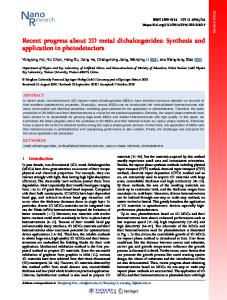Synthesis and structure of two-dimensional transition-metal dichalcogenides
- PDF / 1,124,956 Bytes
- 11 Pages / 585 x 783 pts Page_size
- 103 Downloads / 361 Views
Structure of transition-metal dichalcogenides Atomically thin transition-metal dichalcogenides (TMDCs) provide a wide range of unique electrical, optical, and thermal properties that do not exist in their bulk counterparts (see the Introductory article in this issue of MRS Bulletin).1,2 Monolayer molybdenum disulfide (MoS2),3 one of the most important and frequently studied TMDCs, exhibits good chemical stability and mechanical flexibility. Meanwhile, its semiconducting nature provides a high ON/OFF current ratio in transistors, and TMDC monolayers (MoS2, WS2, MoSe2, and WSe2) with a direct bandgap give strong bandgap emission.4–6 With large carrier mobility and good mechanical properties, two-dimensional (2D) TMDCs are considered as promising candidates for wearable and flexible systems.4,7 Other TMDC materials, such as molybdenum diselenide (MoSe2), tungsten disulfide (WS2), and tungsten diselenide (WSe2), have also attracted much recent attention.8,9 Being an inorganic graphite analogue, all TMDCs share a similar material structure. Each TMDC layer has a sandwich structure formed by hexagonally packed transition-metal atoms located between two layers of chalcogen atoms. Similar to graphite,
a weak van der Waals (vdW) force holds each TMDC layer together; thus, the bulk crystal can be exfoliated along the 2D surface.
Three main polytypes In a TMDC monolayer, the transition-metal and chalcogen atoms form strong covalent bonds, giving rise to several stacking polytypes and polymorphs. The commonly found structural polytypes of TMDC are 1T, 2H, and 3R, which refer to one (1), two (2), and three (3) layers per unit cell stacking in the tetragonal (T), hexagonal (H), and rhombohedral (R) symmetry, respectively. Considering MoS2 as an example, all three polytypes of MoS2 have regular layered structures with six-fold trigonal prismatic coordination of transition-metal atoms (Mo) surrounded by chalcogen atoms (S).10 One tetragonal-MoS2 is a metastable metallic phase, while 2H-MoS2 and 3R-MoS2 are thermodynamically stable phases that can be found in nature. One tetragonal- and 2H-MoS2 differ only by a transversal displacement of one of the two sulfur planes. As shown in Figure 1a, it has been suggested that lithium-ion intercalation results in the 2H to 1T phase transformation.11 Since the 1T structure is typically unstable, a 1T'′ structure can
Yumeng Shi, Physical Sciences and Engineering, King Abdullah University of Science and Technology, Saudi Arabia; [email protected] Hua Zhang, School of Materials Science and Engineering, Nanyang Technological University, Singapore; [email protected] Wen-Hao Chang, Department of Electrophysics, National Chiao Tung University, Taiwan; [email protected] Hyeon Suk Shin, Department of Chemistry and Department of Energy Engineering, Ulsan National Institute of Science and Technology, South Korea; [email protected] Lain-Jong Li, King Abdullah University of Science and Technology, Saudi Arabia; [email protected] DOI: 10.1557/mrs.2015.121
566
MRS BULLETIN • VOLUME 40 • JUL
Data Loading...











